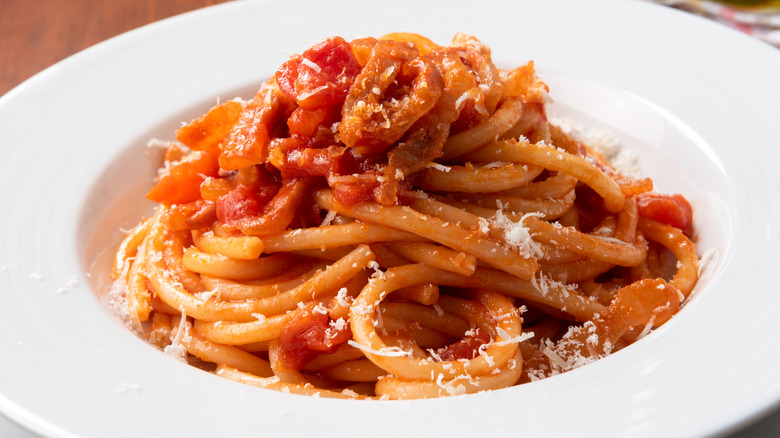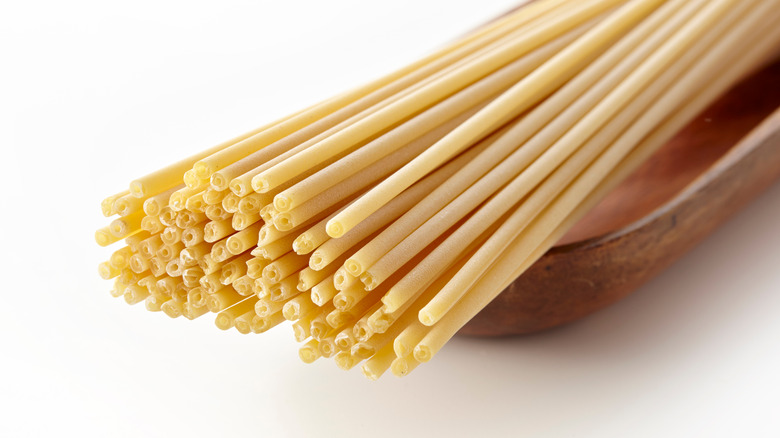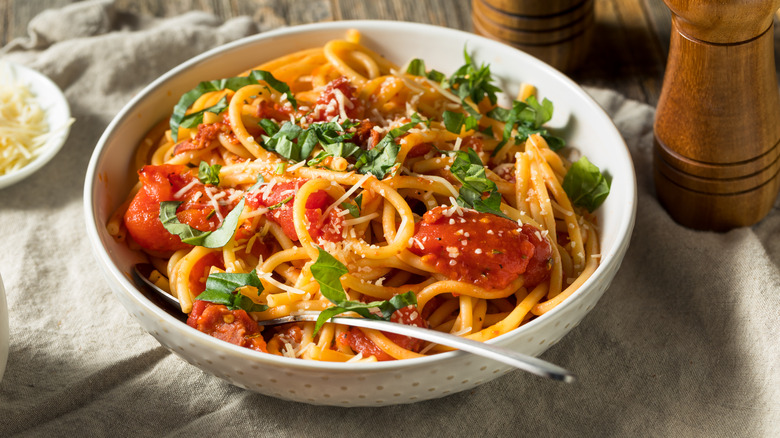What Makes Bucatini Pasta Unique?
In the household of the modern home cook, "pasta night" is a sacred institution. It's filling, inherently fancy yet wicked affordable, and an easy way to get an impressive meal on the table on busy weeknights. But is your go-to Wednesday-evening spaghetti and meatballs starting to get a little redundant?
In a Tasting Table Exclusive Survey, more than ¼ of our readers named spaghetti as their favorite pasta shape, and it's understandable why foodies reach for it over and over again. Spaghetti cooks quickly, is fairly economical, and is simply a familiar comfort at the end of a long day. But, if it's time for a little distance to make the heart grow fonder, meet bucatini: your pasta night savior and new dinnertime ally.
Bucatini Edmonds in Edmonds, WA offers bucatini-based dishes with various accompaniments like meatballs, sausage, and seafood. RPM Italian in Chicago serves up a killer bucatini with pomodoro. So, what exactly makes this type of pasta special?
How bucatini is made
Like many other premium Italian pasta, bucatini is made from durum wheat semolina. According to the USDA's Foreign Agricultural Service, durum wheat for pasta is one of Italy's primary agricultural products. Bucatini is long and thin, not dissimilar to spaghetti or linguine. But, what makes the pasta unique is the long, narrow hole that runs through its center; bucatini is essentially a thicker, hollow spaghetti. The pasta gets its name from this hole, called a "buco" in Italian.
Particularly dauntless home cooks can make bucatini at home, but the process isn't quite as simple as with other hand-rolled pasta. In order to achieve the bucatini's namesake buca, the dough has to be fed into a pasta machine through a perforated disk that punctures the hole through each piece. For this reason, it's probably a good idea to opt for store-bought when it comes to bucatini. It can be found in the average grocery store pasta aisle, but it's also a great excuse to hit up your local pasta shop.
Bucatini's special shape makes it great for sauce and various dishes
Not only does the buco lend an interesting textural component and a chewy mouthfeel, but it also makes bucatini an ideal vehicle: Each pasta strand is a tube full of sauce. According to Thrillist, chef Michele Mazza of NYC's Il Mulino names bucatini as his favorite type of pasta. To showcase bucatini's sauce-carrying capacity, Mazza recommends pairing it with Amatriciana sauce, a spicy Italian red sauce with a smoky, savory flavor that comes from guanciale, a type of cured pig cheek.
Bucatini all'amatriciana is one of the most popular ways that foodies enjoy bucatini in Italy. The dish gets its name from the Italian region of Amatrice northeast of Rome, where it's rumored to have been created by local shepherds. But this is far from the only way to serve and enjoy bucatini. Toss that bucatini with pesto and eggplant; its buco will hold onto the thin sauce for a burst of pesto flavor in every bite. Pair with salty sardines and capers, then toss in a cream-based spicy Calabrian chili sauce for a complex flavor profile with textural diversity.
Sprinkle with pepper, olive oil, and Pecorino Romano, and serve as a light cacio e pepe side dish alongside fish. To bulk it into a heartier entrée, serve bucatini with wild boar ragu and a deep red Cab to complete the meal. For a total departure from traditional pasta dishes, bucatini can be cooked al dente and used to stuff peppers.


